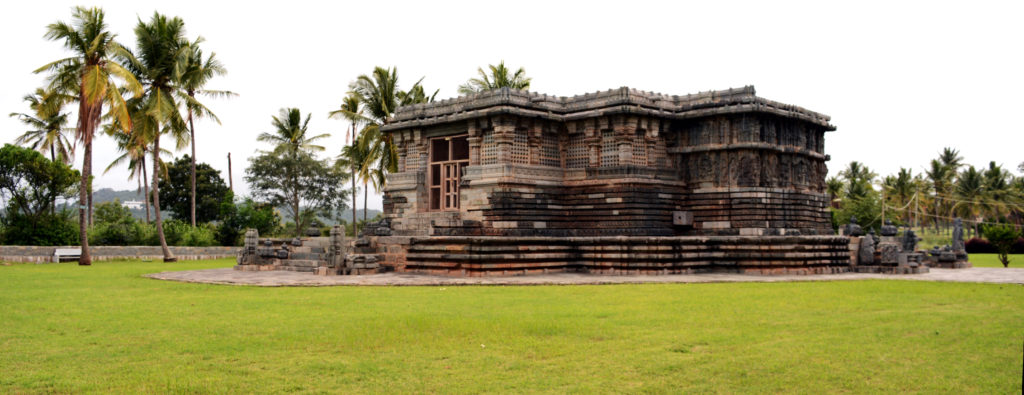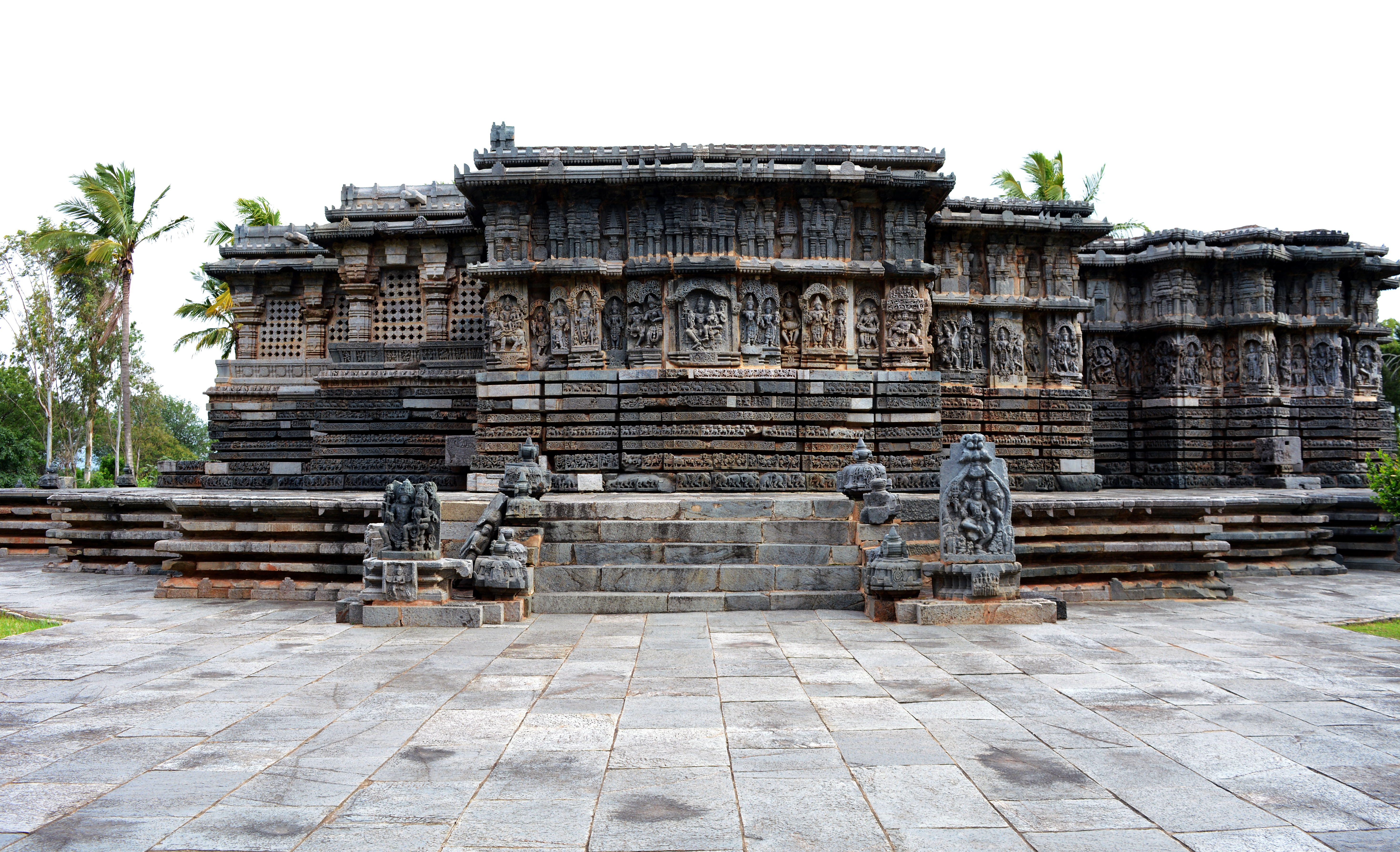Greetings fellow time travelers! It’s your favorite history buff and pun enthusiast, DrifterAdwait is here to take you on a fascinating journey through the lesser-known, but no less impressive, Kedareshwara Temple in Halebidu.
Trust me, this temple is anything but snooze-worthy. With its intricate Hoysala architecture and Vesara style, it’s sure to leave you with a temple-tantrum of excitement. And the sculptures? Well, let’s just say they’re so well-carved, they make Michelangelo’s David look like a toddler’s play-dough creation.
So grab your time-turners and let’s delve into the world of Kedareshwara Temple – the hidden gem of Halebidu! (Disclaimer: No time-turners were harmed in the making of this blog.)
Halebeedu is known to one thing: Hoysaleshwara temple. And indeed, it lives up to its reputation. But just in backyard of this architecture marvel, there is a structure none the less beautiful, patiently waiting for centuries, to be recognized. Let’s begin!

One temple, three shrines or Trikutachala, Kedareshwara temple is a twin to Hoysaleshwar temple, but without Nandi Shrines in front. It was built by Hoysala King Veer Ballala II with his queen Ketaladevi during period 1173 to 1220 A.D. This temple is dedicated to Mahadev. Temple follows almost each and every norms of Hoysala architecture except presence of Nandi. Temple is located on the opposite banks of lake Dwarsamudra. Main shrine has a Shiv Lingam, but for the rest of the two shrines, Idols are missing. Either they were stolen, or vandalized.
After you get down at Halebidu bus stand, keep Hoysaleshwar on your left, and start walking. Take a first left, keeping the Jain temple on your right, you will reach Kedareshwara, situated on the banks of serene Dwarsamudram lake.

ASI has done a brilliant job maintaining the site. Remove shoes outside and walk in. The temple is surrounded with modern aged stone wall and lush green lawns and well trimmed trees. From outside, temple looks like exact replica of Hoysaleshwar. Brilliant outer walls and destroyed towers. As you climb the stairs, broken turrets are kept on each step on both sides of the stairs as a reminder of foreign invasion.


As you walk inside, you see lathe polished and designed pillars holding a brilliant ornate roof. Ceiling is divided in many squared bays bordering the imperceptible carvings. While standing in the middle bay, you will face main shrine, occupied by Shiv Lingam and two empty shrines on each side.

The central bay is brilliantly decorated with inverted lotus like stoned chandelier, made up of rocks. Light drips through stony windows, through a rocky mesh, just enough to dodge flying bats.

Hoysala temples do not have an internal path encircling the main deity. They believe in more subtle way of doing it by creating fantastic outer wall sculptures, make you take your time to circle the complete temple, instead of just a deity statue. Star shaped design of platform and outer walls provides extra room, a bigger canvas for chiseler to work his magic. But, after looking at the things they have composed here, even this shape, shrinks somewhere.
Each and every square feet of wall is loaded with abstracts illustrating legends from Puranas, Ramayan and Mahabharat. Brahma, Vishnu and Mahesh are here, along with their many forms. Hoysala’s favorite GajasurSamhara mahadev is also present here on outer walls accompanying Varaha avatar. As usual, the platform is carved in with many layers. Bottom layer is designed with elephants expressing the strength while one layer above that is made up of horse riders showing the swiftness of the army. Upper layer is made up of lions attacking the elephants indicating courage and Makar layer above that bespeak of protectors of temples and throne.
Take your time here, as even smallest sculpture will portray stories. I found out Pitamah Bhisma lying on bed of arrows, Putana getting killed by Krishna, Lord Ram shooting Vali in back and many more. I sat for a while on platform, trying to grasp the creation in front of me.
This whole area is kind of separated from the town, paddy fields and coconut plantation on both sides of the roads. Farmers were coming back with their bullocks, after back breaking day in the field. They are patting their animal friends on their backs with gratitude. Here lies some kind of silent aloofness, which takes you back to the good old times. Once, at its peak, these capital streets must have been buzzed with citizens, merchants, soldiers, sculptors, artists and many more. Cumulative uproar, sound of mantras chanted by priests, that of sculptors chisel on stones, that of ensemble performing in front of Kedareshwara, merchant selling his Mesopotamian goods. What a chaos must have been there..

I could not help myself but to imagine how these people must have lived? what were their traditions? what were their aspirations? did they thirst for knowledge? What kind of clothes they wore? what were their sources for entertainment? what was the role of government and religion in their lives? were they self satisfied or were they envious with past or future generations like us? What was the position of woman in their culture? I could not help myself but wonder, that they must have known some things that we have forgotten over period of time. No primitive civilization could have created such an architectural wonder that stands for centuries, without some wisdom. As it was getting dark and rainy, I gathered my things, opened umbrella, and wearing my sandals, started walking back to Hoysala Bus depot, with many more questions.

Despite the missing idols, the Kedareshwara temple remains a remarkable example of the Hoysala architecture and a testament to the craftsmanship of its builders. Its intricate carvings, delicate sculptures, and stunning architecture make it a hidden gem in the world of heritage sites. As we explored its halls and marveled at its beauty, we couldn’t help but wonder about the missing idols and their mysterious fate. Perhaps they will one day be found, restored to their rightful place, and complete the divine triad of the Kedareshwara temple. But until then, we can still appreciate the temple for what it is: a breathtaking piece of history that transports us to a different time and place. So, if you ever find yourself in the vicinity of Halebidu, don’t forget to visit the Kedareshwara temple and discover its secrets for yourself!
How To Reach Kedareshwara Temple?
? By Car: Situated on the banks of Dwarsamudra lake, surrounded by coconut plantations and lush green rice paddy fields, Halebidu is a small-sized town. 25 km away from Belur. Halebidu is 210 km away from Bangalore, can be reached by Mysuru road, within 3.5 hours on a super smooth highway.
? By Bus: Frequent KSRTC buses are operated from Bangalore to Hassan every half hour.
? By Train: Hassan (27 KMS) is the nearest railway station to Halebidu. You can get government buses or private vehicles to reach there from Hassan.
? Buy Air: Nearest Airport to Halebeedu is Mangalore airport which is 168 KMS away.
Where to Stay at Halebeedu?

?️ KSTDC has a budget hotel named Mayura Shantala, just beside the Hoysaleshwara temple. You can stay there if you wish to explore this town some more.
The tariff is ranging from Rs.1099 to Rs.2099 as per your choice.
Also, it has a kitchen with decent food options for lunch and dinner.
You can book the hotel here.






